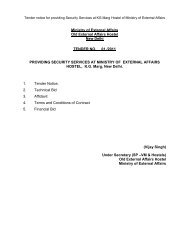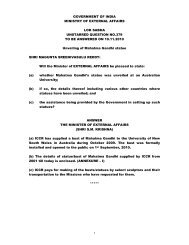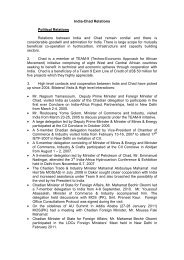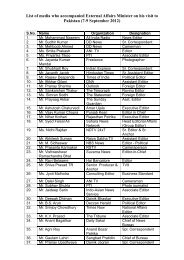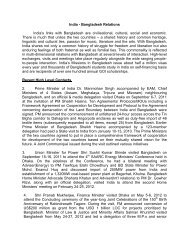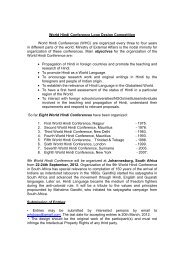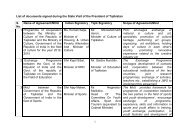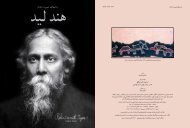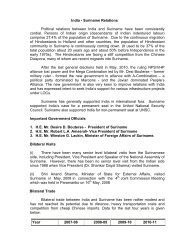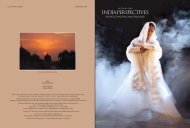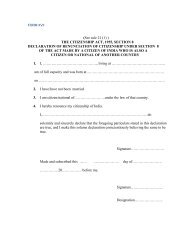IP_ Tagore Issue - Final.indd - high commission of india mauritius
IP_ Tagore Issue - Final.indd - high commission of india mauritius
IP_ Tagore Issue - Final.indd - high commission of india mauritius
You also want an ePaper? Increase the reach of your titles
YUMPU automatically turns print PDFs into web optimized ePapers that Google loves.
In a letter to his daughter,Rabindranath <strong>Tagore</strong> hadonce commented thatpainting wasn’t really hisforte – had it been so hewould have demonstrated whatneeded to be done. But muchbefore this lament, in an earlierepistle addressed to J.C. Bose(1858-1937), he had mentionedin an ebullient tone that itwould surprise the latter tolearn that he had been paintingin a sketchbook, although theeffort with the pencil was beingovertaken by the effort withthe eraser, such that Raphaelcould lie peacefully in hisgrave without the fear <strong>of</strong> beingrivaled.The multifarious personality <strong>of</strong>Rabindranath covered diverseterrains <strong>of</strong> creative expression,but he ventured into the world<strong>Tagore</strong> selecting his paintings in Moscow<strong>of</strong> painting quite late in life.The pages <strong>of</strong> his manuscripttitled Purabi, a book <strong>of</strong>poems published in 1924, isconventionally identified as thefirst evidence <strong>of</strong> articulationthrough full fledged visualimages. In the process <strong>of</strong>editing and altering the text <strong>of</strong>these poems, the poet beganjoining together the struck-outwords in rhythmic patterns <strong>of</strong>linear scribbles, with the resultthat these connected erasuresemerged into consolidated,united and independent identityas fantastic visual forms. Aboutthis process, he later wrote: “Ihad come to know that rhythmgives reality to that which isdesultory, which is insignificantin itself. And therefore, whenthe scratches in my manuscriptcried like sinners, for salvation<strong>Tagore</strong> at his exhibition at the GalleryPigalle with Victoria Ocampo (seated).and assailed my eyes with theugliness <strong>of</strong> their irrelevance,I <strong>of</strong>ten took more time inrescuing them into a mercifulfinality <strong>of</strong> rhythm than incarrying on what was myobvious task.” (‘My pictures’, 1;28 th May 1930).The Purabi correctivecancellations, deleting theunnecessary and unwanted,finally fused together intoa unity <strong>of</strong> design; but morethan that, this rhythmicinterrelationship gave birthto a host <strong>of</strong> unique forms,most <strong>of</strong>ten queer, curiousand grotesque. This nearlysubconscious birth <strong>of</strong> forms,springing up unpremeditatedon the sheet <strong>of</strong> paper, is anecessary corollary to the poet’sinnate concern with rhythm. Itwas not the sheer delectablebeauty <strong>of</strong> swirling arabesquesAll paintings illustrated in this essay areby Rabindranath <strong>Tagore</strong>.that interested the poet, but theemergent unpredictable thatdelighted him. These creaturesmay certainly defy classificationaccording to strict conventions<strong>of</strong> zoology, but are very muchvalid as entities in a painter’sworld. They even possessdistinctly identifiable moods,emotions and characteristics,such that they becomepersonalities rather than blankforms.The manuscript is a privateand personal domain;as the presence <strong>of</strong> theseemergent forms began todemand more independentexistence, the poet-painterturned to full scale paintings.However, having originatedfrom the subconsciousplayfulness <strong>of</strong> the erasures,somewhat unfortunatelyand for a considerable time,Rabindranath’s pictorial practicetended to carry the stigma <strong>of</strong>being a dilettante’s dabble.While it is true that he didnot possess any academicinitiation into the domain <strong>of</strong>the visual arts, he did takelessons in painting in hischildhood, as most childrendo, from home-instructors.In his reminiscences titledChelebela (my childhood days)Rabindranath had recalled howin the interminable sequence<strong>of</strong> home-instructors, an artteacher would immediatelystep in once the instructor inphysical education had justleft. While that is no pleasantrecollection that may inspirelater indulgence in the visualarts, in the Jeebansmriti (Myreminiscences) he had recordeda slightly different childhoodmemory – at bed-time he wouldstare at the patterns <strong>of</strong> peelingINDIA PERSPECTIVES VOL 24 NO. 2/2010 28 INDIA PERSPECTIVES VOL 24 NO. 2/2010 29




